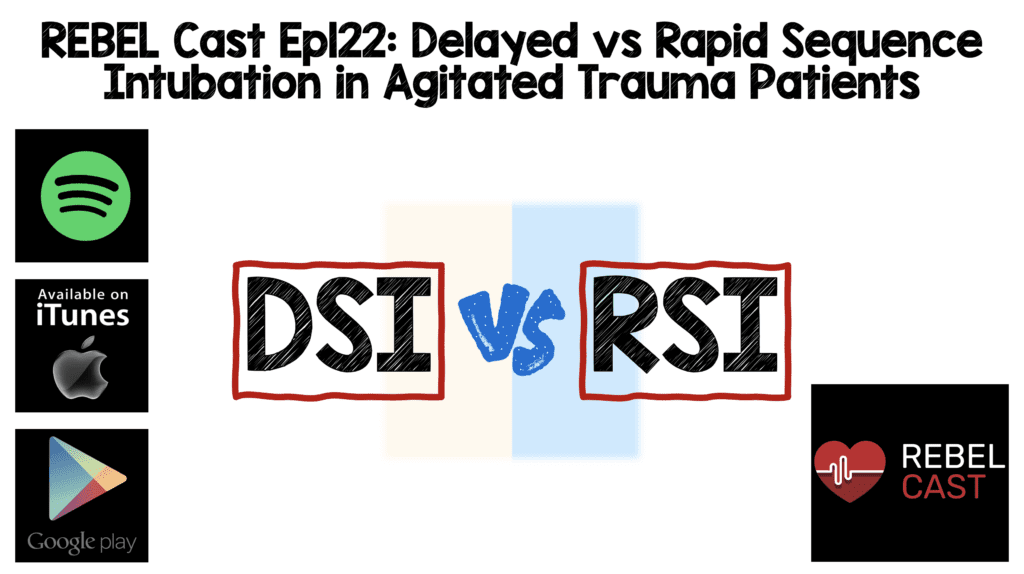
Traditional RSI entails preoxygenation followed by near-simultaneous administration of an induction agent followed by a neuromuscular blocker. Rapid sequence intubation can be modified for patients who are agitated or combative and not tolerating standard preoxygenation. Delayed sequence intubation (DSI) uses a dissociative dose of ketamine, goal-directed preoxygenation for a minimum of 3 minutes, followed by a neuromuscular blocker and ultimately intubation. This helps relieve agitation/pain while maintaining spontaneous breathing and airway reflexes allowing for adequate pre-oxygenation as well as facilitates other resuscitation interventions including IV access, vasopressors, fluids, etc. that would not be possible in an agitated/combative patient.
REBEL Cast Ep122: Delayed vs Rapid Sequence Intubation in Agitated Trauma Patients
Paper: Bandyopadhyay A et al. Peri-Intubation Hypoxia After Delayed Versus Rapid Sequence Intubation in Critically Injured Patients on Arrival to Trauma Triage: A Randomized Controlled Trial. Anesth Analg 2023. PMID: 37058727
Clinical Question: Does delayed sequence intubation decrease peri-intubation hypoxia in trauma patients requiring definitive airway control compared to rapid sequence intubation?
What They Did:
- Prospective randomized clinical trial
- Patients randomized to:
- Delayed Sequence Intubation (DSI):
- IV ketamine 1.5mg/kg in 0.5 mg/kg increments until dissociation was achieved (patient is calm but spontaneously breathing)
- Preoxygenation for 3 minutes
- IV succinylcholine 1.5mg/kg
- Intubation
- Rapid Sequence Intubation (RSI):
- 3min preoxygenation
- IV ketamine 1.5mg/kg
- IV succinylcholine 1.5mg/kg
- Intubation
- Characteristics common to both groups
- All intubations were performed by a 2nd year postgraduate anesthesia resident
- Patients were preoxygenated via spontaneous tidal breathing for 3 minutes using a facemask with oxygen running at 10LPM
- Intubations performed using direct laryngoscopy in both groups
- Oxygen saturation recorded at baseline, then every 1 minute for 3 minutes during the period of preoxygenation and 1 minute after intubation
- Delayed Sequence Intubation (DSI):
Outcomes:
- Primary: Incidence of peri-intubation hypoxia (spO2 <93% anytime from preoxygenation until 1 minute after intubation)
- Secondary:
- First-attempt success rate
- Intubation attempt defined as any insertion of laryngoscope beyond teeth irrespective of intubation success
- Use of adjuncts
- Airway injuries
- Hemodynamic parameters (Hypotension = SBP <100mmHg; Bradycardia = HR <60BPM)
- First-attempt success rate
Inclusion:
- Adult trauma patients
- Presenting to a trauma facility
- Requiring definitive airway
Exclusion:
- Anticipated difficult airway
- Defined as difficulty with anyone of the following:
- Mask ventilation
- Laryngoscopy
- Tracheal intubation
- Extensive burns
- Active vomiting
- Crash intubations
- Cardiac arrest
- Defined as difficulty with anyone of the following:
Results:
- 13,500 trauma patients
- 1000 intubations
- 542 out of hospital intubations excluded
- 245 patients excluded
- 236 patients randomized
- Another 36 patients excluded due to unanticipated difficult airways
- Leaving 200 critical patients (100 in each group) requiring definitive airway management
- Demographics of Note:
- Most common reason for intubation was AMS due to polytrauma with associated head injury (Median GCS: DSI 6 vs RSI 6)
- Motor vehicle accident most common cause of trauma in 82% of patients
- Peri-Intubation Hypoxia (Primary Outcome):
- DSI: 8%
- RSI: 35%
- P <0.001
- First Attempt Success:
- DSI: 83%
- RSI: 69%
- P = 0.02
- No statistically significant difference in airway-related adverse events in either group (DSI 9% vs RSI 16%; p = 0.13)
- No episodes of hypotension, arrhythmias, or cardiac arrest in either group
Strengths:
- 1st RCT on DSI vs RSI in critically injured patients requiring intubation
- Asks a clinically important question
- Clearly defined DSI, RSI, peri-intubation hypoxia, and 1st pass success
Limitations:
- Intubating and record keeping anesthesiologist were unblinded to group allocation making investigator bias a possibility
- All intubating anesthesiologists were still in training and the results could be different for more experienced physicians
- All intubations done with direct laryngoscopy instead of video laryngoscopy, and the results could be different if video laryngoscopy used as 1st choice
- Primary outcome is a monitor oriented outcome and not a patient oriented one
- Demographics reported are limited (i.e. Severity scores, number of patients hypoxemic or hypotensive prior to intubation, rate of agitation, etc…)
Discussion:
- Sample size calculation by authors: Assuming incidence of peri-intubation hypoxia to be around 57% in trauma patients and a 20% absolute reduction in incidence of peri-intubation hypoxia in DSI group vs RSI group, 97 patients would be required in each group for appropriate sample size and power
- Trauma patients with agitation/delirium tend not to cooperate with facemask application for preoxygenation. Re-oxygenation with BMV can increase airway-related adverse events (i.e. aspiration) and therefore adequate preoxygenation is crucial to decrease the incidence of peri-intubation hypoxemia which DSI showed in this trial
- DSI clearly did better than RSI in this agitated cohort of patients: Median SpO2 values were significantly higher in the DSI group compared to the RSI group at all time points, except at baseline, where SpO2 was higher in the RSI group (RSI 92% vs DSI 91%)
- Preoxygenation/1st Attempt Success
- Of the 17 patients who could not be intubated on first attempt in DSI, 8 were due to desaturation which required BMV
- Of the 35 patients who could not be intubated on first attempt in RSI, 31 were due to desaturation which required BMV
- The main reason 1st attempt success was not achieved in both groups was due to desaturation which occurred significantly more in RSI compared to DSI
- Additionally all intubations were done by 2nd year anesthesiology residents with direct laryngoscopy; Many factors such as operator experience, patient-related factors, advanced equipment such as video laryngoscopy, or bougie could all have impacts on 1st-attempt success
- This outcome should be looked at as hypothesis generating, but does beg the question…should DSI become the defacto mode of intubation over RSI?
Author Conclusion: “DSI appears promising in critically injured trauma patients who do not allow adequate preoxygenation due to agitation and delirium and require definitive airway on arrival.”
Clinical Take Home Point: In altered/agitated trauma patients not tolerating pre-oxygenation, who need definitive airway control, DSI reduces the incidence of peri-intubation hypoxia compared to RSI and should be the go to strategy for intubation.
References:
- Bandyopadhyay A et al. Peri-Intubation Hypoxia After Delayed Versus Rapid Sequence Intubation in Critically Injured Patients on Arrival to Trauma Triage: A Randomized Controlled Trial. Anesth Analg 2023. PMID: 37058727
Post Peer Reviewed By: Anand Swaminathan, MD (Twitter: @EMSwami)



